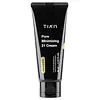What's inside
What's inside
 Key Ingredients
Key Ingredients

 Benefits
Benefits

 Concerns
Concerns

 Ingredients Side-by-side
Ingredients Side-by-side

Water
Skin ConditioningButylene Glycol
HumectantNiacinamide
SmoothingDimethicone
EmollientGlycerin
HumectantSalix Alba Bark Water
Astringent1,2-Hexanediol
Skin ConditioningBetaine
HumectantHydroxyethyl Acrylate/Sodium Acryloyldimethyl Taurate Copolymer
Emulsion StabilisingCetearyl Olivate
Sorbitan Olivate
EmulsifyingZinc Oxide
Cosmetic ColorantEthylhexylglycerin
Skin ConditioningCetearyl Alcohol
EmollientZinc PCA
HumectantPanthenol
Skin ConditioningAllantoin
Skin ConditioningSodium Hyaluronate
HumectantXanthan Gum
EmulsifyingEthyl Hexanediol
SolventWater, Butylene Glycol, Niacinamide, Dimethicone, Glycerin, Salix Alba Bark Water, 1,2-Hexanediol, Betaine, Hydroxyethyl Acrylate/Sodium Acryloyldimethyl Taurate Copolymer, Cetearyl Olivate, Sorbitan Olivate, Zinc Oxide, Ethylhexylglycerin, Cetearyl Alcohol, Zinc PCA, Panthenol, Allantoin, Sodium Hyaluronate, Xanthan Gum, Ethyl Hexanediol
Water
Skin ConditioningGlycerin
HumectantMethyl Gluceth-20
HumectantDimethicone
EmollientDipropylene Glycol
HumectantCarbomer
Emulsion StabilisingTromethamine
BufferingAloe Barbadensis Leaf Extract
EmollientPropanediol
SolventCaprylyl Glycol
EmollientAcrylates/C10-30 Alkyl Acrylate Crosspolymer
Emulsion StabilisingSalix Alba Bark Extract
AstringentButyl Avocadate
Skin ConditioningDimethiconol
EmollientEthylhexylglycerin
Skin Conditioning1,2-Hexanediol
Skin ConditioningButylene Glycol
HumectantDisodium EDTA
Pectin
Emulsion StabilisingSodium Hyaluronate
HumectantChlorella Emersonii Extract
Skin ConditioningPropyl Gallate
AntioxidantCeramide NP
Skin ConditioningHydrogenated Lecithin
EmulsifyingSucrose Stearate
EmollientCholesterol
EmollientCholesteryl Macadamiate
EmollientStearic Acid
CleansingPalmitic Acid
EmollientHydrolyzed Lupine Protein
Skin ConditioningSaccharide Isomerate
HumectantOxygen
Skin ConditioningMentha Piperita Oil
MaskingRosmarinus Officinalis Leaf Oil
MaskingJuniperus Mexicana Oil
MaskingLavandula Angustifolia Oil
MaskingCitrus Aurantium Bergamia Fruit Oil
MaskingLimonene
PerfumingLinalool
PerfumingWater, Glycerin, Methyl Gluceth-20, Dimethicone, Dipropylene Glycol, Carbomer, Tromethamine, Aloe Barbadensis Leaf Extract, Propanediol, Caprylyl Glycol, Acrylates/C10-30 Alkyl Acrylate Crosspolymer, Salix Alba Bark Extract, Butyl Avocadate, Dimethiconol, Ethylhexylglycerin, 1,2-Hexanediol, Butylene Glycol, Disodium EDTA, Pectin, Sodium Hyaluronate, Chlorella Emersonii Extract, Propyl Gallate, Ceramide NP, Hydrogenated Lecithin, Sucrose Stearate, Cholesterol, Cholesteryl Macadamiate, Stearic Acid, Palmitic Acid, Hydrolyzed Lupine Protein, Saccharide Isomerate, Oxygen, Mentha Piperita Oil, Rosmarinus Officinalis Leaf Oil, Juniperus Mexicana Oil, Lavandula Angustifolia Oil, Citrus Aurantium Bergamia Fruit Oil, Limonene, Linalool
 Reviews
Reviews

Ingredients Explained
These ingredients are found in both products.
Ingredients higher up in an ingredient list are typically present in a larger amount.
1,2-Hexanediol is a synthetic liquid and another multi-functional powerhouse.
It is a:
- Humectant, drawing moisture into the skin
- Emollient, helping to soften skin
- Solvent, dispersing and stabilizing formulas
- Preservative booster, enhancing the antimicrobial activity of other preservatives
Butylene Glycol (or BG) is used within cosmetic products for a few different reasons:
Overall, Butylene Glycol is a safe and well-rounded ingredient that works well with other ingredients.
Though this ingredient works well with most skin types, some people with sensitive skin may experience a reaction such as allergic rashes, closed comedones, or itchiness.
Learn more about Butylene GlycolDimethicone is a type of synthetic silicone created from natural materials such as quartz.
What it does:
Dimethicone comes in different viscosities:
Depending on the viscosity, dimethicone has different properties.
Ingredients lists don't always show which type is used, so we recommend reaching out to the brand if you have questions about the viscosity.
This ingredient is unlikely to cause irritation because it does not get absorbed into skin. However, people with silicone allergies should be careful about using this ingredient.
Note: Dimethicone may contribute to pilling. This is because it is not oil or water soluble, so pilling may occur when layered with products. When mixed with heavy oils in a formula, the outcome is also quite greasy.
Learn more about DimethiconeEthylhexylglycerin (we can't pronounce this either) is commonly used as a preservative and skin softener. It is derived from glyceryl.
You might see Ethylhexylglycerin often paired with other preservatives such as phenoxyethanol. Ethylhexylglycerin has been found to increase the effectiveness of these other preservatives.
Glycerin is already naturally found in your skin. It helps moisturize and protect your skin.
A study from 2016 found glycerin to be more effective as a humectant than AHAs and hyaluronic acid.
As a humectant, it helps the skin stay hydrated by pulling moisture to your skin. The low molecular weight of glycerin allows it to pull moisture into the deeper layers of your skin.
Hydrated skin improves your skin barrier; Your skin barrier helps protect against irritants and bacteria.
Glycerin has also been found to have antimicrobial and antiviral properties. Due to these properties, glycerin is often used in wound and burn treatments.
In cosmetics, glycerin is usually derived from plants such as soybean or palm. However, it can also be sourced from animals, such as tallow or animal fat.
This ingredient is organic, colorless, odorless, and non-toxic.
Glycerin is the name for this ingredient in American English. British English uses Glycerol/Glycerine.
Learn more about GlycerinSodium Hyaluronate is hyaluronic acid's salt form. It is commonly derived from the sodium salt of hyaluronic acid.
Like hyaluronic acid, it is great at holding water and acts as a humectant. This makes it a great skin hydrating ingredient.
Sodium Hyaluronate is naturally occurring in our bodies and is mostly found in eye fluid and joints.
These are some other common types of Hyaluronic Acid:
Learn more about Sodium HyaluronateWater. It's the most common cosmetic ingredient of all. You'll usually see it at the top of ingredient lists, meaning that it makes up the largest part of the product.
So why is it so popular? Water most often acts as a solvent - this means that it helps dissolve other ingredients into the formulation.
You'll also recognize water as that liquid we all need to stay alive. If you see this, drink a glass of water. Stay hydrated!
Learn more about Water